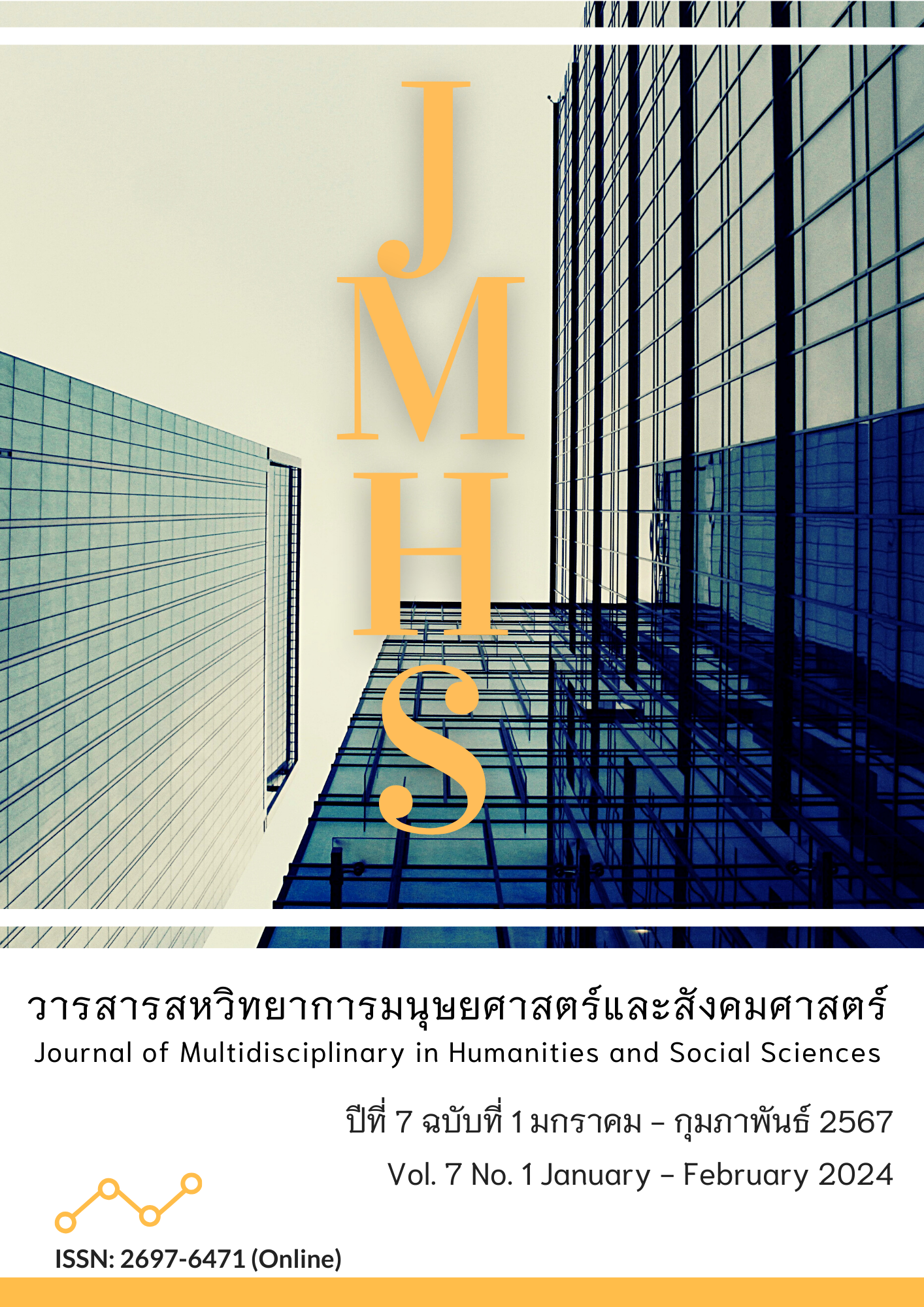The Tourism Recreation Activities Management According Recreation Opportunity Spectrum by Geographic Information System of Community Tourism Village, Lampang Province
Main Article Content
Abstract
The objectives of the study were to 1) classify the Recreation Opportunity Spectrum areas of Lampang community tourist villages and 2) design induction modules and community communication for the spatial management of Lampang tourism villages. The research model is a combination methods that using Geographic Information System (GIS) and the concept of Recreation Opportunity Spectrum according to classification of recreation opportunity class. The research area is Lampang province, using the province's community tourism village as a sample groups. The instrument used in the research is the Geographic Information System program.
The study was found that 1) The tourism community villages was in Lampang Province. Most of the area is in the Semi-Primitive Non-Motorized natural area (SPNM), followed by Rural Natural Modified (RNM), Primitive (P), Semi-Primitive Motorized Natural Areas (SPM), Rural Areas (R) and Urban Areas (Urban) and 2) Modular learning lessons and community communication for spatial management of Lampang tourism village has designed and operated a community spatial management training modular learning based on Recreation Opportunity Spectrum concept (ROS) in Lampang province. to manage tourism recreation activities and tourism experiences in accordance with the ecosystem and community for increase the potential of communities to sustainable tourism.
Article Details

This work is licensed under a Creative Commons Attribution-NonCommercial-NoDerivatives 4.0 International License.
Views and opinions appearing in the Journal it is the responsibility of the author of the article, and does not constitute the view and responsibility of the editorial team.
References
กริช อัมโภชน์. (2540). การฝึกอบรมหลักสูตรการบริหารงานฝึกอบรม. กรุงเทพฯ: สถาบันบัณฑิตพัฒนบริหารศาสตร์.
ขวัญฤทัย ครองยุติ, ดวงศิริ ภูมิวิชชุเวช และ นฤมล สุมาร. (2561). การประเมินและจำแนกช่วงชั้นโอกาสทางด้านนันทนาการในแหล่งท่องเที่ยวทางธรรมชาติ จังหวัดเชียงราย. วารสารวิทยาลัยดุสิตธานี, 12(3), 102-117. สืบค้นจาก https://so01.tci-thaijo.org/index.php/journaldtc/article/view/240951
คณะวนศาสตร์ มหาวิทยาลัยเกษตรศาสตร์. (2547). คู่มือการจำแนกเขตท่องเที่ยวเชิงนิเวศ. กรุงเทพฯ: มหาวิทยาลัยเกษตรศาสตร์.
ดรรชนี เอมพันธุ์, สุทัศน์ วรรณะเลิศ และเรณุกา รัชโน. (2547). คู่มือการจำแนกเขตท่องเที่ยวเชิงนิเวศโดยหลักการช่วงชั้นโอกาสด้านนันทนาการ. กรุงเทพฯ: มหาวิทยาลัยเกษตรศาสตร์.
เพชรศรี นนทศรี. (2561). รูปแบบการดําเนินงานของกลุ่มท่องเที่ยวโดยชุมชน ในเขตภาคเหนือตอนล่าง. วารสารการท่องเที่ยวไทยนานาชาติ, 8(2), 47-65. สืบค้นจาก https://so02.tci-thaijo.org/index.php/jitt/article/view/25298
วาสนา ทองตัน. (2555). การประยุกต์ระบบสารสนเทศภูมิศาสตร์เพื่อจำแนกเขตการท่องเที่ยวด้วยหลักการช่วงชั้นโอกาสด้านนันทนาการ อุทยานแห่งชาติน้ำหนาว จังหวัดเพชรบูรณ์. วารสารการท่องเที่ยวไทยนานาชาติ, 8(1), 1-30. สืบค้นจาก https://so02.tci-thaijo.org/index.php/jitt/article/view/25371
ศศิกานต์ บุญเมือง, ดรรชนี เอมพันธุ์ และ สันต์ เกตุปราณีต. (2556). การประยุกต์ช่วงชั้นโอกาสด้านนันทนาการในการจัดการพื้นที่กางเต็นท์ในอุทยานแห่งชาติแก่งกระจาน. วารสารวนศาสตร์ไทย, 31(3), 65-74. สืบค้นจาก https://li01.tci-thaijo.org/index.php/tjf/article/view/255620
สำนักงานนโยบายและแผนทรัพยากรธรรมชาติและสิ่งแวดล้อม กองสิ่งแวดล้อมชุมชนและพื้นที่เฉพาะ. (2562). การวิเคราะห์ขีดความสามารถในการรองรับพื้นที่. กรุงเทพฯ: แสงสว่างเวิลด์เพรส.
Aklıbaşında, M., & Bulut, Y. (2014). Analysis of Terrains Suitable for Tourism and Recreation by Using Geographic Information System (GIS). Environ Monit Assess, 186, 5711–5719. https://doi.org/10.1007/s10661-014-3814-6
Bayarsaikhan, T., Kim, S. & Tommy, G. T. (2020). International Tourists’ Destination Choice Differences According to Plog’s Personality Types: Analyzing the Case of Mongolia Based on The Recreation Opportunity Spectrum. International Journal of Urban Sciences, 24(4), 485-515. https://doi.org/10.1080/12265934.2020.1771195
Bishop, I. D., & Gimblett, H. R. (2000). Management of Recreational Areas: GIS, Autonomous Agents, and Virtual Reality. Environment and Planning B: Planning and Design, 27(3), 423–435. https://doi.org/10.1068/b2637
Brown, P. J. (1982). Recreation Opportunity Spectrum with Implications for Wildlife Oriented Recreation. Conference Proceeding Transactions of The Forty-Seventh North American Wildlife And Natural Resource Conference. (pp. 705-711). Missoula: University of Montana.
Carrol, J. (2015). Developing a Measurement Protocol for the Tourism Opportunity Spectrum. Scholarworks.umass.edu. Retrieved 2020, June 10, from https://scholarworks.umass.Edu/cgi/viewcontent.cgi?article=1082&context.
Herlina, S., Leily S R., & Praja, F. (2021). Recreation Opportunity Spectrum Analysis of Strategic Area Tourism Destination Pelang Region. E-Journal of Tourism, 8(2), 172-183. https://doi.org/10.24922/eot.v9i2.91384
Huang, C., & Confer, J. J. (2009). Applying The Tourism Opportunity Spectrum Model in Nature-Based Tourism Management. Managing Leisure, 14(4), 247-257. https://doi.org/10.1080/13606710903204449
Tangian, D., Bernadain, D. P, Seska M. H., & Mengko. (2018). Model Micro-ROS in Utilization of Sustainable Tourism. In Proceedings of the First International Conference on Applied Science and Technology (iCAST 2018), (pp. 181-185). Atlantis.
Zeng, W., Zhong, Y., Li, D., & Deng, J. (2021). Classification of Recreation Opportunity Spectrum Using Night Lights for Evidence of Humans and POI Data for Social Setting. Sustainability, 13(14), 7782; https://doi.org/10.3390/su13147782

